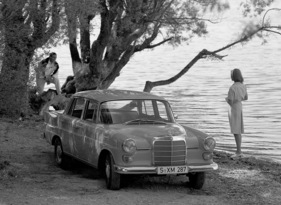Mercedes-Benz 190 D - Diesel without mountain complexes
Summary
The magazine 'hobby' wanted to know exactly: Does a diesel have to be lazy in the mountains? To answer this question, the Mercedes-Benz 190 D was put to the test on wintry Alpine passes in 1962. The account of the experiences is as entertaining as it is impressive. And the Mercedes passed the test with flying colors. This article edits the test report of the time and supplements the few pictures with extensive archive material.
This article contains the following chapters
- Challenge on a wintry mountain
- On the road with ice tires
- Uphill and downhill
- Advantages and disadvantages of ice tires
- Great progress compared to the 170 D
- You can also drive quickly with diesel
- Lots of overtaking potential
- Also suitable for the 'weaker sex'
- Economical
- Reliable starter
- Bombastic acceleration
- The test results at a glance
Estimated reading time: 8min
Preview (beginning of the article)
If a car is to be tested primarily for its hill climbing ability and safety, it is probably still not a bad idea to juggle it through a city with heavy traffic and steep gradients as soon as you receive it (at mileage 20,986). Then you know exactly what the vehicle, occupied by two people but made up to four 'occupants' by two additional sandbags, will consume in the worst case. In this way, the Mercedes-Benz 190 D covers 287 real city kilometers on 29.1 liters, giving an average 100-km consumption of 10.1 liters. Something like this must have upset a 'mixed test double', which had achieved an average city consumption of 6.8 liters in similar experiments with the old 170 D in the early 1950s.
Continue reading this article for free?
Photos of this article































































